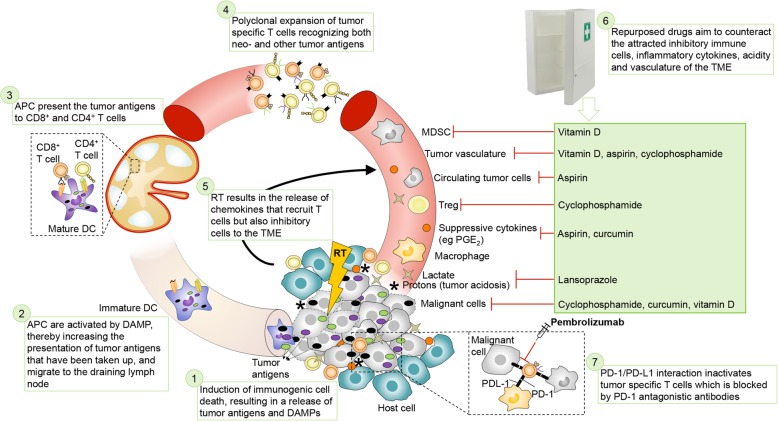Fig. 1.
Proposed mode of action of the combination treatment. (1) Immunogenic cell death, resulting in tumor antigen (TAA) release and production of danger-associated molecular patterns (DAMPs), is induced by radiation, low-dose cyclophosphamide, curcumin and vitamin D. (2) The released TAA can be taken up by immature dendritic cells (DC) for processing through the antigen processing machinery. In the presence of DAMPs, DCs will mature and (3) migrate to tumor-draining lymph nodes to prime antigen-specific CD4+ and CD8+ T lymphocytes. (4) The primed, tumor-specific CD4+ and CD8+ T cells enter the bloodstream and undergo clonal expansion. (5) Radiation induces chemokine secretion to recruit the tumor-specific CD4+ and CD8+ T cells into the tumor to kill tumor cells. However, these chemokines also attract inhibitory cells into the TME. (6) Primed, tumor-specific CD4+ and CD8+ T cells can be inhibited by several mechanisms, which we aim to counter with repurposed drugs. Tumors maintain an acidic microenvironment by the production of protons and lactate and T cells become dysfunctional in this acidic environment. Lansoprazole will induce buffering of the extracellular pH by inhibiting vacuolar H+-ATPase resulting in proper functioning of T cells. The tumor vasculature is abnormal, leading to hypoxic regions in which T cells become dysfunctional. Low-dose cyclophosphamide, vitamin D and aspirin will remodel the tumor vasculature to improve T cell functioning. Tumor cells release immunosuppressive cytokines, which might be exacerbated by radiation, and leads to recruitment of myeloid-derived suppressor cells (MDSC) and tumor-associated macrophages (TAM), which inhibit T cells. Aspirin and curcumin will counter some of these cytokines such as PGE2 and vitamin D inhibits myeloid suppressive cells and IL-6, thereby improving T cell function. Tumors are often infiltrated by regulatory T cells (Treg) capable of inhibiting CD8+ T cells, which can be exacerbated by radiation. Low-dose cyclophosphamide can inhibit the suppressive activity of Treg, thereby improving the T cell response. (7) Upon activation, primed CD4+ and CD8+ T cells start to express PD-1, which can be ligated by its ligand PD-L1 on tumor cells or tumor-infiltrating immune cells, thereby limiting their effector functions. This phenomenon can be countered by pembrolizumab. Also curcumin could inhibit inflammation-mediated PD-L1. RT: radiotherapy, DAMP: danger-associated molecular pattern, APC: antigen-presenting cell, TME: tumor microenvironment, Treg: regulatory T cell, MDSC: myeloid-derived suppressor cell

